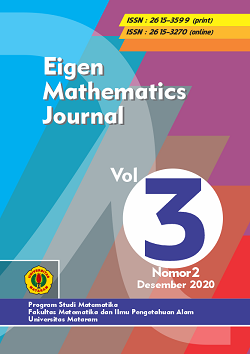Optimasi Penyaluran Bahan Bakar Minyak di Wilayah Maluku Indonesia
DOI:
https://doi.org/10.29303/emj.v3i2.81Keywords:
Fossil oil, Distribution, Mix Integer Linear Programming, variables, systemAbstract
Fossil fuel (BBM) is a vital commodity and has a strategic value for people's lives. On the demand side, the need for BBM tends to increase along with the increasing energy demand for people's lives. Therefore, the distribution system for BBM has to be optimized in order to fulfill the people’s demand. The aim of this paper is to optimize vehicle route for BBM distribution in Maluku so that it has minimum cost, distance, and time. The optimization method in this paper is Mix Integer Linear Programming (MILP). Decision variables in this paper are chosen from the most significant variables for BBM distribution in Maluku.References
Adams, F. G., Griffin, J. M. (1972). An economic-linear programming model of the US petroleum refining industry. J. Am. Stat. Assoc. 67(339), pp. 542–551 .
Adebayo, A. and Dada A. S. (2008). An evaluation ofthe causes of oil pipeline incidents in oil and gas industries in Niger Delta Region of Nigeria. Journal of Engineering and Applied Sciences, 3(3), pp. 279-281.
Akpoghomeh, O.S. and Badejo, D. (2006). Petroleum product scarcity: a review of the supply and distribution of petroleum products in Nigeria. OPEC Review, 30(1), 2740.
Al-Qahtani, K., Elkamel, A. (2008). Multisite facility network integration design and coordination: an application to the refining industry. Comput. Chem. Eng. 32(10), pp. 2189–2202.
An, H., Wilhelm, W.E., and Searcy, S.W. (2011). Biofuel and petroleum-based fuel supply chain research: a literature review. Biomass and Bioenergy, 35(9), pp. 3763-3774.
An, H., Wilhelm, W.E., and Searcy, S.W. (2011). Biofuel and petroleum-based fuel supply chain research: a literature review. Biomass Bioenergy 35(9), pp. 3763–3774.
Anon. (2011). Petroleum liquids pipelines continue to increase transported volumes. Pipeline Gas J. 238(3), pp. 48–51 .
Aronofsky, J. and Williams, A. (1962). The use of linear programming and mathematical models in under-ground oil production. Manage. Sci., 8(4), pp. 394–407.
Auwal, U. and Mamman J.A. (2012). Thedownstream sector: An assessment of petroleum products supply in Nigeria [online]. 5th Annual NAEE/ IAEE International Conference, Abuja, Nigeria. Available at: http://naee.org.ng/files/Auwal_Mamman%20Full%20Paper%20NAEE2012%20( 2).pdf? [Accessed 20 April 2015].
Bravo, J. J. and Vidal, C. J. (2013). Freight transportation function in supply chain optimization models: a critical review of recent trends. Expert Syst. Appl. 40(17), pp. 6742–6757.
Briggs, C.A., Tolliver, D., and Szmerekovsky, J. (2012). Managing and mitigating the upstream petroleum industry supply chain risks: leveraging analytic hierarchy process. Int. J. Bus. Econ. Perspect, 7(1).
Catchpole, A. R. (1962). The application of linearprogramming to integrated supply problems in the oil industry. Operational Research Society, 13(2), pp. 161-169.
Chryssolouris, G., Papakostas, N., and Mourtzis, D., (2005). Refinery short-term scheduling with tank farm, inventory and distillation management: an integrated simulation based approach. Eur. J. Oper. Res., 166(3), pp. 812–827.
Furchtgott-Roth, D. (2013). Pipelines are safest fortransportation of oil and gas [online]. Energyand Environment, Manhattan Institute for Policy Research, 23, pp. 1-10. Available from: http://www.manhattaninstitute.org/pdf/ ib_23.pdf [Accessed 10January 2015].
Kazemi, Y., Szmerekovsky, J. (2015). Transportation Research Part E 83, pp. 111–125.
Downloads
Published
How to Cite
Issue
Section
License
All articles published in the Eigen Mathematics Journal will be available for free reading and downloading. The license applied to this journal is Creative Commons Attribution-Non-Commercial-Share Alike (CC BY-NC-SA).
Similar Articles
- Sulpaiyah Sulpaiyah, Syamsul Bahri, Lisa Harsyiah, Forecasting Rice Price with Double Exponential Smoothing and Fuzzy Time Series Methods (Case Study: Price of Rice in Mataram City) , EIGEN MATHEMATICS JOURNAL: Vol. 5 No. 2 Desember 2022
You may also start an advanced similarity search for this article.
Most read articles by the same author(s)
- Muhammad Agung Nugraha, Farizal Farizal, Djoko Sihono Gabriel, Peramalan Penjualan Kendaraan Mobil Segmen B2B dengan Metode Regresi Linear Berganda, Jaringan Saraf Tiruan dan Jaringan Saraf Tiruan – Algoritma Genetika , EIGEN MATHEMATICS JOURNAL: VOL. 3 NO. 2 DESEMBER 2020





